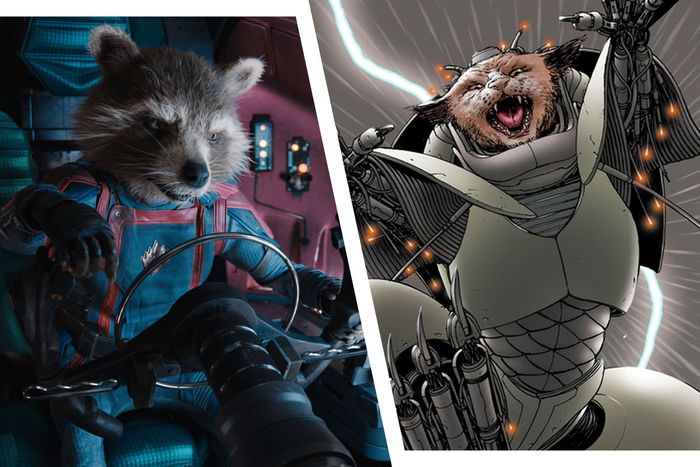
Almost a decade ago, James Gunn expressed an interest in making a movie based on a comic book about adorable little animals who were experimented on and tortured. This weekend, Gunn released Guardians of the Galaxy Vol. 3, which features adorable little animals who were experimented on and tortured. But back in 2014, Gunn wasn’t talking about Rocket Raccoon and the other critter victims of the MCU’s latest supervillain, the High Evolutionary. Instead, Gunn was talking about a three-issue series from 2004 called We3.
The comic is incredible. It is also emotional terrorism on the highest level, and it’s a skeleton key to understanding GotG Vol. 3.
The elevator pitch for We3 can be summed up as “Homeward Bound meets The Terminator.” A collaboration between acclaimed comics writer Grant Morrison and illustrator Frank Quitely, the series follows three animals who have been transformed into cybernetic weapons of war against their will. There’s 1 (Bandit, a dog), 2 (Tinker, a cat), and 3 (Pirate, a bunny rabbit). When a senator visits the illicit research facility and orders that the trio be “decommissioned,” they escape in an attempt to find a home where they can be safe, all with the military hunting them down.
If We3 has a masterstroke, it’s that the three animals can talk, thanks to their cybernetic enhancements, but they’re still animals. They don’t have complex thoughts or a grasp of proper syntax. Bandit, the dog, is the most advanced, though he is fittingly worried about whether or not he is “GUD DOG.” Pirate, the rabbit, has the most basic thoughts, speaking in words rather than anything resembling a sentence. (“GRASS. NOW. EAT. GRASS.”) And Tinker is something of a little shit, which should track if you’re a cat owner. (“BOSSSS! ST!NK!”)
In this way, We3 deliberately stops short of fully anthropomorphizing its main characters. That makes their desperate, confused flight from the people who created them all the sadder, and their search for “HOME” that much more agonizing because they still feel like animals despite being largely encased in sleek, weapons-filled metal exoskeletons.
The animals in Gunn’s Guardians of the Galaxy are more eloquent than We3’s animals, which makes sense, given that Bradley Cooper has been voicing Rocket and it would be a shame to waste his dulcet pipes. We3’s influence is all over Guardians of the Galaxy Vol. 3. That’s not a surprise, given that Gunn has never been shy about his love for the comic, which was published by Vertigo, a now-shuttered arm of DC Comics, Gunn’s new employer.
A few months after the first Guardians of the Galaxy movie came out, Gunn told Morrison via Interview Magazine that We3 was his “favorite short-form comic series, ever,” and that he cries every time he reads it. He also said that Don Murphy, producer of Natural Born Killers and the first two Transformers, kept encouraging him to adapt it into a movie. A year later, Gunn once again expressed his interest in making a We3 movie, writing in a Facebook Q&A that the title would probably be tough to adapt to the screen. He also tweeted last December that We3 remains one of his favorite comics.
That Gunn would fall so hard for We3 makes sense. The comic is agonizingly emotional to the point of being almost manipulative, not unlike some of Gunn’s bighearted and earnest climaxes, including in the Guardians films (see: Groot’s self-sacrifice and Yondu’s funeral). It is also, thanks to Quitely’s stellar art, extremely violent — the opening scene is a graphic close-up of bullets exploding through an assassination target’s skull. Many of Gunn’s movies share a taste for violence, too. You see it in Slither, Super, and especially in his early Troma work, but there are glimpses of it in Vol. 3, too, with its body horror and an entire base made out of … flesh. This combination of heart-wrenching and heart-splattering is foundational to Gunn’s filmmaking.
That might explain why Gunn was so taken with the character of Rocket and why the MCU version has a darker backstory than his comics counterpart. Rocket predates We3 by decades, having debuted in 1976. The Rocket of the comics was genetically created to be an anthropomorphized animal caretaker of a planet full of criminally insane patients. (Comics!) His MCU backstory, as detailed in GotG Vol. 3, is much sadder. He was a cute, innocent baby raccoon who was horribly experimented on by the High Evolutionary. He made friends with other animal experiments, including a rabbit named Floor, who, like We3’s Pirate, is the least articulate animal of the group. And, when he’s to be decommissioned, Rocket makes a daring escape — and not all of his friends make it.
In interviews, Gunn has said that telling Rocket’s story was a key part of why he wanted to come back and make Vol. 3. “He was just fine being an animal, and he was transformed into something else he didn’t want to be,” Gunn told Entertainment Weekly. “I think that transformation itself was extremely painful, but I also think it made him feel incredibly alienated from everyone else.”
Gunn never ended up making a We3 movie, and with the future of the DC cinematic universe on his shoulders, it’s doubtful that he ever will. But he doesn’t really need to anymore. GotG Vol. 3 is We3, wrapped up in a spacefaring superhero package. At the end of both, you’ll find yourself crying over a cybernetic animal who escaped captivity and is looking for love. Looking for HOME.
More on Guardians of the Galaxy Vol. 3
- A Year of Movie Endings
- Guardians of the Galaxy Is Millennial Nostalgia Now
- When Did the Guardians of the Galaxy Adopt a (Space) Dog?

